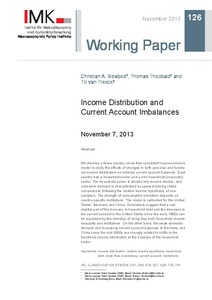Income distribution and current account imbalances
"We develop a three-country, stock-flow consistent macroeconomic model to study the effects of changes in both personal and functional income distribution on national current account balances. Each country has a household sector and a non-household (corporate) sector. The household sector is di...
| Main Author: | |
|---|---|
| Institution: | ETUI-European Trade Union Institute |
| Format: | TEXT |
| Language: | English |
| Published: |
Düsseldorf
2013
IMK |
| Subjects: | |
| Online Access: | https://www.labourline.org/KENTIKA-19122114124919403969-income-distribution-and-curren.htm |
| Summary: | "We develop a three-country, stock-flow consistent macroeconomic model to study the effects of changes in both personal and functional income distribution on national current account balances. Each country has a household sector and a non-household (corporate) sector. The household sector is divided into income deciles, and consumer demand is characterized by upward-looking status comparisons following the relative income hypothesis of consumption. The strength of consumption emulation depends on country-specific institutions. The model is calibrated for the United States, Germany and China. Simulations suggest that a substantial part of the increase in household debt and the decrease in the current account in the United States since the early 1980s can be explained by the interplay of rising (top-end) household income inequality and institutions. On the other hand, the weak domestic demand and increasing current account balances of Germany and China since the mid-1990s are strongly related to shifts in the functional income distribution at the expense of the household sector." |
|---|---|
| Physical Description: | 61 p. Digital |

